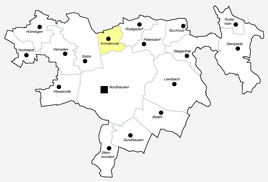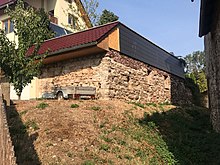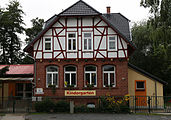Krimderode
|
Krimderode
City of Nordhausen
|
|
|---|---|
| Coordinates: 51 ° 31 ′ 50 ″ N , 10 ° 46 ′ 50 ″ E | |
| Height : | 197 (195-210) m |
| Residents : | 1300 |
| Incorporation : | July 1, 1950 |
| Postal code : | 99734 |
| Area code : | 03631 |
|
Location of Krimderode in Nordhausen
|
|
|
Historic center of Krimderode (2017)
|
|
Krimderode (earlier spelling Crimderode ; dialect Crimderimde ) is a district in the north of the city of Nordhausen in Thuringia .
Geographical location
Krimderode is located two kilometers north of the Nordhausen city center in the extreme southern foothills of the Harz Mountains ; to the west lies Rüdigsdorf Switzerland . Neighboring towns are Niedersachswerfen in the north, Rüdigsdorf in the east, Nordhausen in the south and Salza in the southwest . To the northwest of the village lies the Obersalza and Kohnstein settlement . The Zorge flows through Krimderode with the Mühlgraben, into which the Kappelbach and Krimderöder Bach flow . The place is in the South Harz Nature Park .
Krimderode is surrounded by the elevations Hoffeberg and Kalgberg in the north, Danielskopf (273 m) in the east and Sichelberg (263 m) and Kuhberg (246 m) in the southeast. The Orbach rises between Sichelberg and Kuhberg and flows into the Zorge. At the foot of the Kuhberg lies the Ellersiedlung (also known as Klein-Krimderode ), which was built as an extension of Krimderode in the 1930s. The Grenztriftweg at the Albert-Kuntz-Sportpark forms the border to the district of Nordhausen. West of Ellersiedlung is the (old) "Krimderöder Defense", now a stone weir or Sohlgleite . Directly on Bundesstraße 4, at the transition from the historic town center to the Ellersiedlung, there is a second, presumably more recent, dam. The facility, originally equipped with riflemen , has been an adjustable inflatable weir for several years .
The area around the village is very rich in sinkholes .
history
The Zorgedorf Krimderode is to be distinguished from the village of the same name, which was located on the Märschgraben , southeast of the Rodeberge near Urbach and which became desolate in 1412 , which sometimes makes it difficult to identify medieval documents. According to the Nordhausen regional historian Ernst Günther Förstemann (1788-1859), this place was mentioned in a document in 891 as Criemhilterot . It is also attested for 1268 as a cimilderode and 1281 as a crimolderode .
Krimderode an der Zorge, first mentioned in 1240 in a document from Count Theoderich von Hohnstein, was formerly a Reichsdorf and was under the authority of the Reich Schulzen in Nordhausen until it was bought by the Knight of Bula in 1436. Around 1580, 26 families lived next to the landlord in 21 houses in the village, in 1648 there were 10 families.
The historic center of Krimderode is located near the Evangelical Lutheran Church of St. Nicolai , built around 1580 , which is the oldest building in the village next to the "Old Castle". The old castle is located directly behind the church and dates from 1539/40. The cellars with the late Gothic pointed arched portals and the solid masonry on the south and east sides have been preserved from this construction phase. Around 1599 there was a renovation, the extent of which, however, is incomprehensible. Until the fire in 1609, the old castle served as an apartment for the respective fiefdom owners, including the Wurmb family . The last descendant of this family line died on June 18, 1815 in the Battle of Waterloo . The town's inn was therefore called La Belle-Alliance (after Napoleon's headquarters Belle-Alliance ) and was a popular destination for citizens of Nordhausen. After the fire of 1609, the manor house was built on the estate by the feudal owner, Colonel von Römer. The rebuilt Old Castle served as an office building with a court and prison from 1610 to 1818. After the fire of 1818, which destroyed the upper floor, the house was given to a Crimean wasteland at hereditary interest and mainly used as an apartment. An underground passage led from the cellar into the Sacred Valley. After years of decay, the old castle was demolished in the 1990s, down to the basement, which is now part of a newly built residential building.
The manor of "Grimderode" (1836) had the police the civil and highly embarrassing jurisdiction in the place. In 1850 the jurisdiction was abolished.
Between Niedersachswerfen and Krimderode was the Hanover customs, which was often visited by the citizens of Nordhausen, as goods were cheaper here. After the abolition of the customs border in 1834, the building was converted into an inn by the Count of Stolberg, in which, among other things, the stands of the County of Hohenstein met. In 1848 the future Prussian minister Johannes von Miquel held freedom speeches here . In 1876 customs burned down.
From 1885 the village belonged to the Ilfeld district and from 1932 to the Grafschaft Hohenstein district . By belonging to the Prussian province of Hanover , the parish was part of the Hanoverian regional church ( consistorial district of Ilfeld ).
In 1904 the gypsum factory "Bruno Steuerlein" was founded at the former "Flehmühle". In the following decades it developed from a water-powered gypsum mill to a larger industrial company. The company was nationalized in 1981 and production stopped seven years later. The gypsum factory fell into disrepair in the following years and was demolished in 2000 except for the administration building (built in 1948) and the old shaft furnace, which has been a listed building since then. The shaft furnace was built in the 1870s and is the oldest evidence of the gypsum industry in the Nordhausen area.
Inexpensive building land, low property taxes and rents led to lively construction activity and people moving in, especially from Nordhausen in the 1930s. The number of inhabitants rose from 598 (1935) to 1,080 (1939).
During the occupation of Nordhausen on April 11, 1945 by US troops, there were several incidents with German rear guards in the vicinity of the Kohnstein and in Krimderode. A German group blew up the rocky embankment opposite the Zorge weir of the Jericho mill and blocked the Harzstrasse. Then they took up position on the Liethen above the village and shot at advancing infantry. American units combed the place and threatened the residents to go to Rüdigsdorf. After the German position was attacked with fighter bombers in the late afternoon, the group withdrew towards the Harz Mountains.
At the beginning of 1946, the place took in 400 displaced people from the eastern areas. In 1948 Krimderode was hit by a devastating flood; the damage caused amounted to around 100,000 Reichsmarks .
In March 1948, by order of the Thuringian state government, the spelling of the place name - previously written with the first letter "C" - was changed to "Krimderode". This notation was already in use in the municipal register for the German Reich in 1939 due to the census.
Since July 1, 1950, Krimderode belongs to the area of the city of Nordhausen; the place had 1,670 inhabitants at that time. An incorporation had been sought since the mid-1930s and in August 1938 the Crimean desolation councils approved this. The outbreak of war prevented the incorporation plans, which were taken up again in March 1946. The last mayor of Krimderode was the social democrat Ernst Henneberg.
Krimderode has no local council or district mayor.
education
In 1546 the parish built the first "school house", in 1902 the school building on the Zorge was built, which today serves as a kindergarten. In 1948 the foundation stone for the Polytechnic Oberschule (POS) “Dr. Jan Cespiva ”, which was built almost entirely from rubble from the city of Nordhausen. The residents volunteered over 20,000 hours during the construction. The Protestant Primary School in Nordhausen has been housed in the school building since 2002.
Culture and sights
- Flehmüller's oak
The oak tree on the Liethberg (235 m above sea level ) above Krimderode, which is around 600 to 1000 years old, is one of the oldest natural monuments in the southern Harz. In 2015, the chest height was 7.25 meters, with a height of 21 meters. The pedunculate oak known as Flehmüller's oak stood in a forest that has been gradually felled since 1829. In 1840, the then Krimderöder manor Drechsler applied to the Hochgräflichen Stolberg-Hohnstein Consistory for the preservation of the oak. Since 1992 the “oak festival” has been held under the tree in June. In 1995, an approx. 15 year old oak was planted in the immediate vicinity.
- Krimderöder Carnival Club
The Krimderöder Carnival Club is one of the oldest carnival clubs in the Nordhausen district.
Residents
| year | Residents |
|---|---|
| 1600 | 120 |
| 1817 | 230 |
| 1900 | 490 |
| 1910 | 592 |
| 1925 | 601 |
| 1933 | 789 |
| 1935 | 598 |
| 1939 | 1070 |
| 1950 | 1670 |
traffic
Krimderode is located on Bundesstraße 4 and has a station on the Harzquerbahn .
With the Kaiserweg (Harz) and Karstwanderweg , two long-distance hiking trails lead through the village.
Personalities
- Margarete Aurin (1897–1989), Montessori teacher, childhood and youth in Krimderode
- Gustav Drechsler (1833–1890), agricultural scientist, lived in the manor
- Friedrich Thimme (1868–1938), historian and publicist, born in Krimderode
Oddities
"Wisselbeeren" are wild cherries that were found in large quantities in and around Krimderode in the 18th century and were often used as a topping for cakes, especially at fairgrounds . This brought the residents the local necropolis , Wisselbeerkönige , Twisselbeerkönige or Wisselbeerhengste .
literature
- Leni Arnold: Krimderode 1946 to 1950 . In: Contributions to the history of the city and district of Nordhausen . Nordhausen-Salza, Iffland, Vol. 35, 2010, pp. 7-26.
- Hans-Jürgen Grönke : From the history of Krimderode and the surrounding area . In: Nordhäuser Nachrichten. Südharzer Heimatblätter , Vol. 13, 2004, 4, pp. 6-8.
- Wilhelm Vahlbruch: Home booklet of the Graffschaft Hohnstein in the district of Ilfeld (southern Harz) . Crimderode 1927, p. 24.
- Wilhelm Vahlbruch: Manners and Customs in Crimderode . In: home country. Illustrated homeland sheets for the southern foreland of the Harz , 1904, pp. 19-20. on-line
- Wilhelm Vahlbruch: The village of Crimderode in all kinds of war needs . In: home country. Illustrated homeland sheets for the southern foothills of the Harz , 1904, pp. 51–54. on-line
Individual evidence
- ↑ a b Leni Arnold: Krimderode 1946 to 1950 . In: Contributions to the history of the city and district of Nordhausen . Nordhausen-Salza, Iffland, vol. 35.2010, p. 20.
- ^ Ernst Günther Förstemann: Small writings on the history of the city of Nordhausen , Ferd. Förstemann, Nordhausen 1855. p. 69.
- ^ Karl Meyer: The desertions of the county of Stolberg-Stolberg , Nordhausen 1871, p. 284.
- ↑ Hans-Jürgen Grönke: From the history of Krimderode and the surrounding area . In: Nordhäuser Nachrichten. Südharzer Heimatblätter , Vol. 13.2004, 4, pp. 6-8
- ↑ Adolf Ziemann: Library of the entire German national literature . Volume 1, Basse, Quedlinburg 1835, p. 34.
- ↑ a b Hans-Jürgen Grönke: From the history of the "Bruno Steuerlein gypsum factory" in Krimderode - the production buildings and their functions until the company closed , in: Contributions to the history of the city and district of Nordhausen (Volume 26/2001) . Pp. 14-24.
- ↑ Jürgen Möller: The fight for the Harz April 1945 . Rockstuhl, Bad Langensalza 2011. p. 127.
- ↑ Municipalities 1994 and their changes since January 1, 1948 in the new federal states , Metzler-Poeschel publishing house, Stuttgart, 1995, ISBN 3-8246-0321-7 , publisher: Federal Statistical Office
- ↑ a b c Leni Arnold: Krimderode 1946 to 1950 . In: Contributions to the history of the city and district of Nordhausen . Nordhausen-Salza, Iffland, vol. 35.2010, p. 7.
- ↑ Flehmüllerseiche directory monumental oaks . Retrieved January 10, 2017
- ↑ a b Wilhelm Vahlbruch: Heimatbüchlein der Graffschaft Hohnstein in the Ilfeld district (southern Harz) , Crimderode 1927. P. 24.
- ^ Justus Ludwig Günther Leopold: Church, parish and school chronicle ... , Nordhausen, Weichelt, 1817. P. 105
- ↑ http://www.ulischubert.de/geografie/gem1900/gem1900.htm?hannover/ilfeld.htm
- ^ Landratsamt Nordhausen (ed.): Today and then - 2001: 9th year book of the Nordhausen district . Neukirchner Verlag, Nordhausen 2002. Page 54
- ↑ Women's project at the Umweltakademie Nordthüringen eV (Ed.): Refreshments from the region: Nicknames from the Nordhausen district . Regionale-Verlag, Auleben 1999, p. 40.











